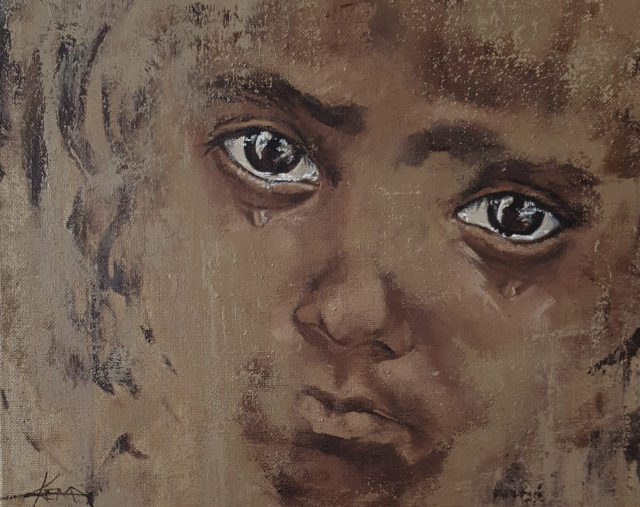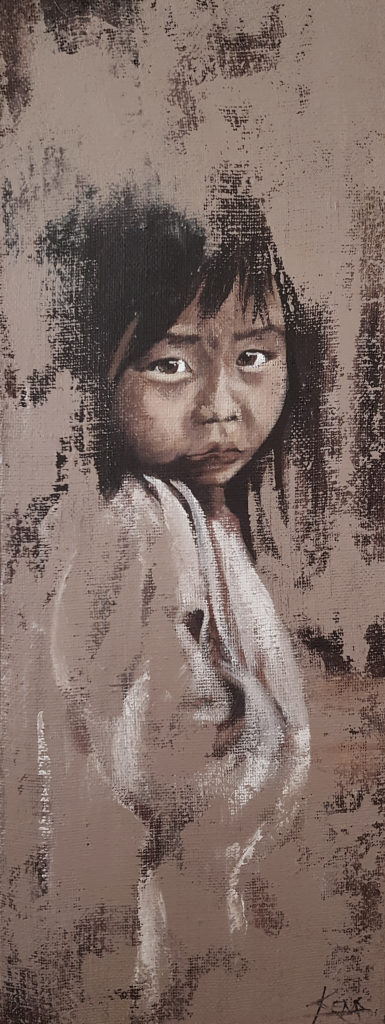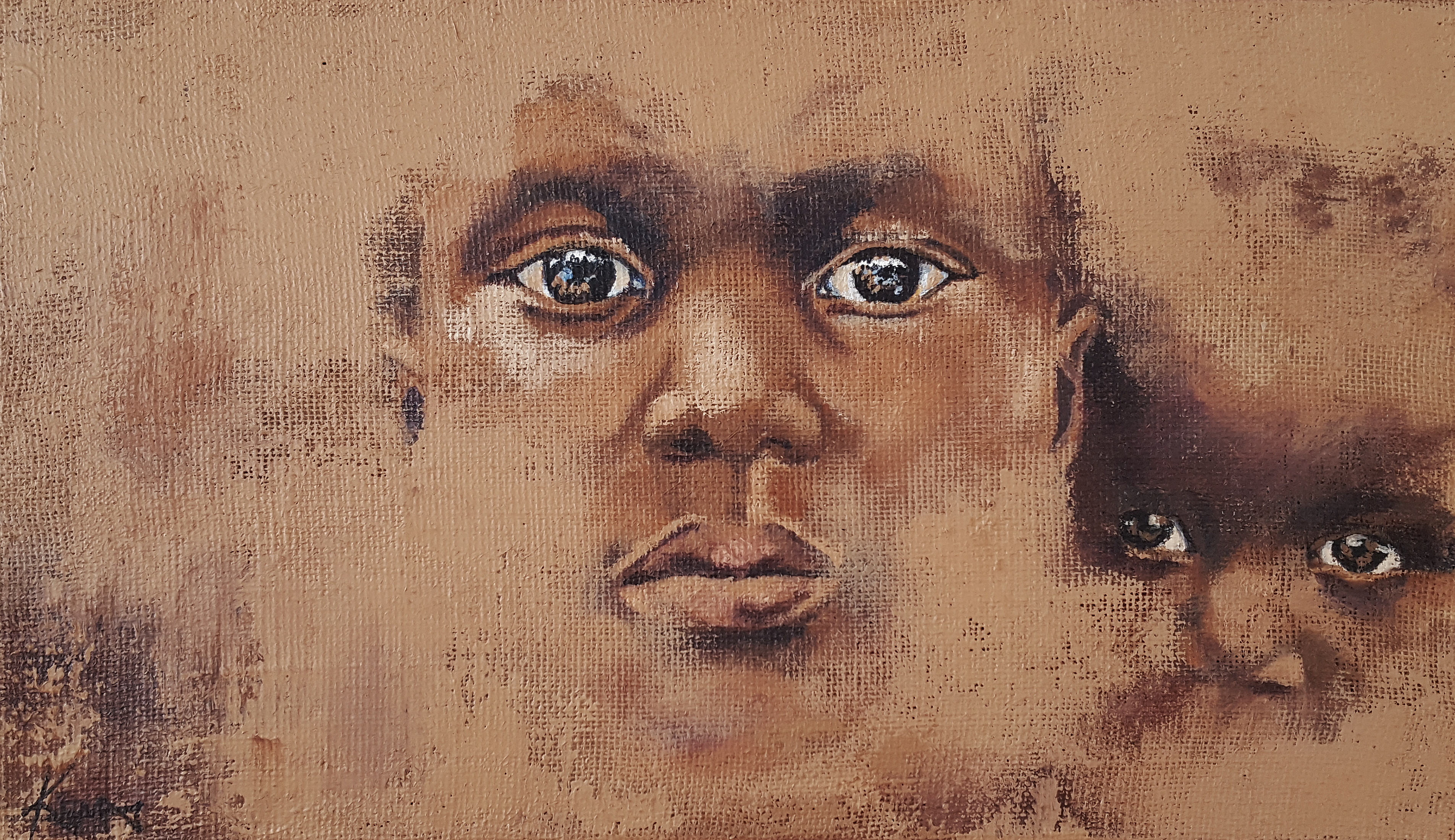
For the past several years, Loren Eiseley’s story “The Star Thrower,” aka “the starfish story,” has made its rounds across the internet. Published in the late 1960s, the story has been retold with varying details for the past few decades. In one of its iterations, it loosely follows a child on a beach filled with washed up starfish. A man comes along and tells the child that he’ll make no difference just throwing one starfish back into the ocean. The child responds that it will make a difference to that one starfish.
It’s a story that moved artist Kema Berry. She’s used the narrative before in her exhibits, and she uses the metaphor to drive her work. For Berry, the difference she hopes to make in the world is an effort to curb the human trafficking epidemic affecting nations all over the globe.
“I thought, ‘How can I make a difference? What’s my one little starfish?’” she asks. “I can make a noise and get more people on the shore to throw the starfish in with me.”
She’s making noise through her exhibit entitled Through Their Eyes, showing at the Dairy Arts Center through April 15. The show features Berry’s work depicting victims of human trafficking — mostly children — staring right at the viewer as their faces and bodies fade into the burlap on which they’re painted.
A pamphlet provided by the exhibit cites the 2016 Global Slavery Index that estimates forced labor and human trafficking generates an annual $150 billion profit. More than 45 million people are subjected to modern-day slavery, 168 million are in child labor and close to 5 million women and children are victims of sex trafficking. Through her work, Berry seeks to shed light on varying issues including forced prostitution, sale and exploitation of children, debt bondage, involuntary servitude, removal of organs and servile marriage.

Berry’s awareness began indirectly with her journey into clean eating a few years ago. She wanted to better understand the products she was consuming, and steer clear of GMOs and hormone-laced products, which led her to researching the chain of supply and where her food was actually coming from. She discovered a plethora of information and tragic realizations about the human labor behind many products.
“Not just food; in our garments, in our Christmas lights,” Berry says. “Little kid’s fingers are used because they’re smaller, and I can’t look at twinkle lights the same now.”
She realized her power as a consumer to buy fair trade instead of from companies exploiting labor, but she wanted to do more. She felt as if there weren’t enough people addressing the severity of the problem.
“There are government web sites that are tracking the numbers, but how can you really track a number that’s under the radar? It was 30 million plus and now it’s 40 million plus,” Berry says. “But how do they count those numbers? It’s not foolproof, and it’s probably an underestimation. I became aware, and I thought to utilize my tools that I’ve been given to further awareness.”
Figuring out how to visualize the problem of modern-day slavery was Berry’s biggest task. She didn’t want to create art that was exploitative or too difficult to consume — she didn’t want to turn people off from the work.
“I wanted to evoke emotive quality to the plight of the people,” she says. “But if you’re making something that you don’t want to see, then a person would turn away from it, as opposed to be drawn into it and moved by it. It leaves more room for us to think more about it versus just passing by and not holding on to it because it’s too painful or too ugly to look at.”
For this project she strived to capture the weight of suffering experienced by so many with just a few representative subjects. While her pictures don’t tell specific, individual narratives, the anonymity speaks to the many individual stories that make up the whole. Many of these stories and people have been lost over the years, and Berry wanted to help them find an audience.
“We’ll read an article and our hearts will be compelled and we’ll feel saddened for these invisible people out there, but then we’ll forget,” she says. “So I thought of how to get hold of a [viewer] to see longer.”
Berry used the eyes as the portal for connection.

“The eyes hold the humanness of each of us. And the suffering of those eyes was depicted in order to convey the soul of the people through a plight of one person. Because there are so many, and how can we represent so many?” Berry says. “I thought the eyes are the window to the soul. We connect with eyes, who we are inside, not what we look like on the outside. I wanted to bring that to life.”
Also, by using abstraction and not painting completely realized portraits, Berry invites the audience to wonder about the narratives. This choice serves to capture the elusiveness of their stories, eliciting a desire to hold onto these images, and these people, before they fade away.
“We don’t know them personally, but when we view the souls of the many through the eyes of the few, we can see that we’re common and connected,” she says. “We’re all the same.”
While there’s an immense sadness in the work, some portraits capture the resilience of the soul. Behind the sad eyes and cries for help, a spark of hope perhaps survives.
“‘Africa’ is probably my favorite [painting]. This young lady seems to be telling me, ‘I’m going to stand strong and proud and walk tall in spite of the circumstances that I was given,” Berry says. “She’s wanting to stay and be strong through the adversity of her life.”

Along with Berry’s images, the exhibit features participatory artwork from the Red Sand Project. The organization provides free bags of eco-friendly red sand and encourages participants to spread the sand on a sidewalk to symbolize the millions of people who fall through the cracks of human trafficking. By taking a photo and posting it to social media with the hashtag #RedSandProject, it’s another avenue for raising awareness.
A portion of art sales from Through Their Eyes will also go to support Pathfinder Center, a non-profit organization in North Dakota that provides services, shelter and protection to victims of human trafficking.
Berry’s goal with her work is to galvanize her audience. She hopes to continue connecting with more organizations and finding more ways to promote outreach.
“I want to help and be a part of [ending] the epidemic of human trafficking. It’s calling people to help with the starfish,” Berry says. “The more we become aware through all the different media out there the more we can do. You can’t do anything unless you’re aware of it. I’m hopeful that [the U.S.] and other Western countries realize that we can do something if there’s enough of us.”














